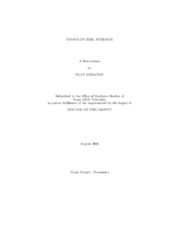| dc.description.abstract | This dissertation contains three essays on risk aversion. In the first essay, we an-
alyze comparative risk aversion in a new way, through a comparative statics problem
in which, for a cost, agents can shift from an initial probability distribution toward
a preferred distribution. The Ross characterization arises when the original distribution is riskier than the preferred distribution and the cost is monetary, and the
Arrow-Pratt characterization arises when the original distribution differs from the
preferred distribution by a simple mean-preserving spread and the cost is a utility
cost. Higher-order increases in risk lead to higher-order generalizations, and the com-
parative statics method yields a unified approach to the problem of comparative risk
attitudes.
In the second essay, we analyze decisions made by a group of terrorists and a
government in a zero-sum game in which the terrorists minimize a representative
citizen's expected utility and the government maximizes it. The terrorists' strategy
balances the probability and the severity of the attack while the government chooses
the level of investment reducing the probability and/or mitigating the severity. We
find that if the representative citizen is risk neutral, the terrorists' response is not
associated with the government's action and the representative citizen's risk attitudes
affect the strategies of the government and the terrorists. Risk aversion always in-
creases equilibrium severity but does not always increase equilibrium expenditure of the government.
In the last essay, we consider a situation in which an individual has to pay for
a good before he realizes the state-dependent surplus of the good. This ex-ante
willingness to pay is called the option price and the difference between the option
price and the expected surplus is the option value. We find that the option value
actually is the buying price for a fixed payment of the expected surplus, and there is
a special case in which the option value equals the negative of the compensating risk
premium. We also find the effects on the option price and the option value when the
expected utility assumption is replaced by a rank-dependent expected utility. | en |


